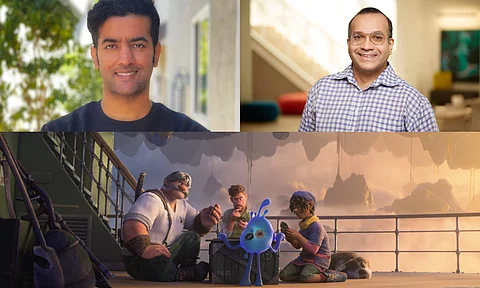

The first thing that strikes our mind when we mull over the differences between animation and live-action films is how entire worlds are created straight out of one’s mind in the former. To be technically accurate, an animated film springs out of several minds. From the heartwarming chuckle of young Simba to “A Whole New World” shown by Aladdin to Jasmine, every frame you see on screen is a painting crafted by adept technicians and ingenious artists and nobody has a richer and longer history of doing that than Walt Disney Animation. To try and understand the process of how technicians breathe life into raw imagination, we talked to Chatrasal Singh (animator) and Norman Joseph (Technical Director) at Walt Disney Animation who both worked on Disney’s upcoming film Strange World.
When asked what defines good animation, Chatrasal Singh draws upon years of insights to confidently declare, “Story is king. With the kind of tools available in the industry today, almost every studio is able to create stunning visuals. The only thing that sets you apart is the story. We at Disney always keep saying that ‘Story is King’ so for me, a good story is the foundation of a good animated film.” If the story is the foundation, then the building is definitely built on technology, and that is when someone like technical director Norman Joseph comes in. “Technical directors are responsible for making sure that the artists are able to accomplish their tasks using technology. If they come up with a new request and want to achieve something new, we analyse that request and see if it is technically feasible.”
This feasibility is a major aspect of translating the mind's vision to the screen, and Chatrasal gives us a step-by-step insight into that process. “It begins with a story pitch, then the director works with an art department to sketch the entire film into storyboards. Then we model the characters, create layouts and animation before sending it to the lighting department after which the film moves to the rendering stage.”
While there are many levels to the immensely collaborative effort, Chatrasal’s animation team works specifically on the performance of the characters. “Sometimes, we act it out ourselves,” he chuckles before continuing, “Every artist has their own way of trying to bring their emotions onto the characters. Some animators like to sketch emotions. Someone like me, who cannot sketch too well, would act in front of the camera and then animate our characters to emote the same way.” Apart from the depth provided by the voice cast, a part of the animator’s performance, as it seems, is also poured into the film.
This revelation also means that from an animator's point of view, there are a lot of similarities between making an animated film and a live-action film. But how does a technical director see the difference in the making of these two types of films? “Both films are hard to make. But in an animation film, you need to build it all from the scratch. Everything from a blade of grass to an entire world has to be created and rendered," shares Joseph.
Drawing inspiration from live performances is not something new for Disney. They have done it right from the 1951 animated adaptation of Alice in Wonderland, where Kathryn Beaumont, apart from voicing Alice in the film, also performed scenes for the animators. This tradition has managed to stay alive till Strange World. “We have videos of the actors performing while delivering the dialogues and we pick up facial nuances and try to incorporate it in the film,“ says Chatrasal, adding, “When an actor is lending their voice to a character in an animation film, they are not exactly performing the actual scene but their body language still informs our animation process.”
Directed by Don Hall, Strange World boasts an impressive ensemble cast that includes Jake Gyllenhaal, Lucy Liu, Dennis Quaid, Jaboukie Young-White, Gabrielle Union, Karan Soni, and Alan Tudyk.
Talking about the uniqueness of Strange World, Joseph says, “The film has amazing environments in it. I loved watching the character Splat on screen, and the way it was made to emote even though it does not have conventional humanoid facial features.” On the other hand, Chatrasal shares that his favourite characters from the film are Ethan and Searcher. "I found it easier to relate to Searcher and his son Ethan since I am a new father myself, and the film is all about the relationship between a father and son. If I want to empathise with the character, I dig into something personal that has happened in my life to try and connect with the character at that moment in the film.”
The conversation then moved toward the animation scene in India and Norman Joseph's optimism for the potential for homegrown animation was apparent. “There are a wealth of stories in India and even now as we speak, there are so many Indian films that are getting mainstream attention from the international audience and it is a matter of time that success translates to our animation industry.”
He then backed up his optimism with advice for Indians hoping to get into the animation industry, “The time for the Indian animation scene is now. There are plenty of competent animation studios in India. It's all about making connections, getting the right resources, and learning from the resources and on top of that, you need to keep doing what you love to do. Animation is a vast industry and figuring out what you would like to do in that industry would be the first question to figure out,” he signs off.